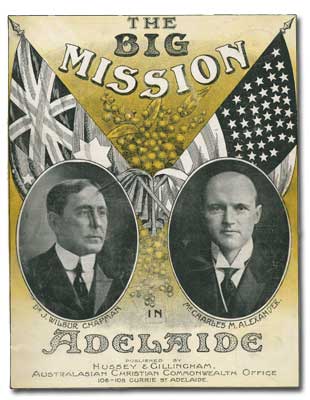
Religion : Mission

The term 'mission,' in a theological context, refers to four aspects of religious action. Most often it is associated with evangelical missionary work - the Christian church seeking to convert non-believers. (Mission is an activity which is most often seen in the work of the Christian church, rather than in other religions.) Other aspects of mission include establishing new churches, deepening and renewing the faith of those who already believe, and finally, in working to relieve suffering and promote justice and peace throughout the world.
The early European colonists saw the conversion of the Aboriginal people to Christianity as a priority. The German 'Evangelisch-Lutherischen Missionsgesellschaft zu Dresden' (the Evangelical Lutheran Missionary Society of Dresden) sent four young men to South Australia in the 1840s specifically for this task. The missionaries recorded invaluable information about the culture, language and beliefs of the Aboriginal people. In 1850 an Anglican Aboriginal mission was founded at Poonindie, and in 1859 the Point MacLeay (Raukkan) Mission was established by the Aborigines' Friends' Association. Later the Lutherans and Moravians established Aboriginal missions in the centre of Australia at Kopperamanna, Killalpininna and Hermannsburg. Despite little outside financial assistance and against major difficulties, these became important centres of Aboriginal community life.
Revival and temperance missions were the most popular method of re-invigorating churches and bringing back lapsed, or attracting new members, to churches in the 19th and 20th centuries. American revivalists, beginning with 'California' Taylor, attracted large audiences, as did the temperance advocate Matthew Burnett. Women preachers were novel, but firmly part of the process - Serena Thorne attracted thousands to her meetings across South Australia in the 1870s. In 1959 the American, Billy Graham, preached to an estimated 60,000 people at Wayville. From the latter part of the 20th century annual revival missions such as the 'Charismatic convention' and 'Keswick convention' attracted pious church members. Groups including Scripture Union ran beach missions for children and adults through the Australian summers.
Many churches had 'Bush Missions' - mostly men who worked as itinerant preachers in the north and mid-north of the state. Men such as John Flynn (the 'flying doctor') were dedicated to improving the lives of those who lived in the outback. With them were many women - deaconesses, nuns and nursing sisters - who, though less conspicuous, worked equally hard. It was the early women missionaries who first promoted the belief that improving the well-being of the people they worked amongst was an essential dimension of mission, regardless of the likelihood of creating converts.
This provision of support to those in need and the struggle for social justice has perhaps become the most enduring arm of mission work. The Adelaide City Mission, Adelaide Central Mission, Salvation Army, and other religious groups have provided a vast range of welfare services to the marginalised for over a century. Many religion-based organisations provide vital advocacy services for those on the fringes of society and lobby governments to work for justice, not only in the local community but also on the national stage.
Bowden, John, ed. Encyclopedia of Christianity, New York: Oxford University Press, 2005
(Image: Big mission in Adelaide [cover], Adelaide, S. Aust.: Hussey and Gillingham, 1909)
Items 13 - 17 of 17







